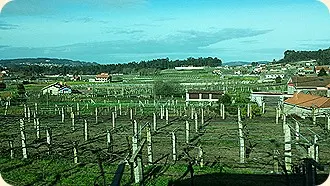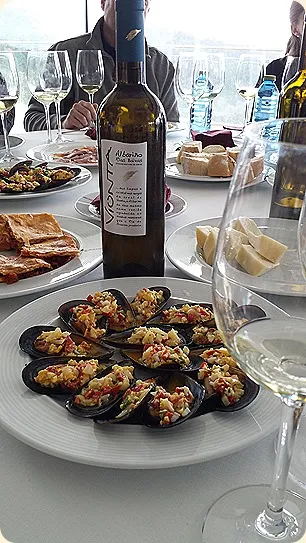What’s the most famous wine of Spain? Many Spaniards will tell you it is the Albariño from the Rías Baixas DO.
Shaped By The Land And Sea
Rías Baixas is Spain’s best known white wine DO (Denominación de Origen), but producing the famed drink is no easy task. In the Oceanic climate of Rías Baixas (REE yahs Bī-SHAHS) it rains about 8 months of the year. What happens two weeks before the harvest can have a tremendous impact on the years work. Heavy rains can cause the grapes to burst and become susceptible to disease. Rot can set in in less than 48 hours. Losses of up the 35% are not unknown.
A Wine Of Culture And Relationships
Each house has its own vines, trellised using pillars made of local granite. In times past, the vines were raised off the ground, allowing farmers to plant potatoes on the ground.
There are 6,700 winegrowers in the region which has only 4,000 hectares. To Bodegas Vionta, a top echelon winery located near Meaño, it means relationships with 50 winegrowers. “It’s part of the culture,” says Pepa Formosa, member of Ferrer Family Wines International Development team. “We always have to buy grapes, but we have to prove what we are doing in the vineyard.”
The Winning Albariño Style
The winery has a contemporary look. Large glass windows look over a valley dotted with oak, pine and eucalyptus trees out to the Atlantic.
The prize of the region, and at Vionta, is Albariño. In Rias Baixas, Albariño accounts for 98% of wine production.
It is a grape whose origin is mysterious. Some believe it is related to Riesling and was brought by monk’s making the pilgrimage from Germany’s Mosel region to the Shrine of St. James in Santiago de Compostela. Others suggest that it is indigenous pointing out that Portugal makes fine wines from the same grape.
“Albariño is like horses,” explained Pepa as we tasted a just bottled sample of 2015 Vionta Albariño. “It needs time to calm down.”
Although Albariño is a delicate grape, the soil and the climate give it muscle. The 2015 was perfect in color, but the acidity was a bit untamed. We compared this to the 2014 vintage, which had a rounder texture and a luscious flavor of mango. For the best Albariño experience, go for a vintage one or two years earlier than the current release to allow it to properly develop.
Oceans of Flavor
The mussels were served with a vinaigrette of onion, peppers, garlic, chopped egg, vinegar and olive oil. As is the local custom, they were steamed in sea water. We could gaze out the window and see the inlet where the mussels were farmed.
The Ruedo DO is garnering attention as an up-and-coming white wine region in Spain. Ferrer Family Wines is present in each of Spain’s top wine regions and their Paramus winery produces Verdejo from 15 to 25-year-old vines. We sampled the Paramus Verdejo along with the 2014 and 2015 Vionta Albariño.
The Verdejo has soft, lush flavors with notes of citrus. The spot-on pairing, however, was the 2014 Vionta Albariño and the mussels. The floral aroma, tropical flavors and carefully crafted acidity are memorable.
Rias Baixas has 198 wineries with a focus on Albariño, a great choice instead of Riesling or Sauvignon Blanc. Chances are some of the grapes come from a family farm. Like those farmers, the winemakers of Rias Baixas take pride in what they produce – the best white wine in Spain.







No comments:
Post a Comment